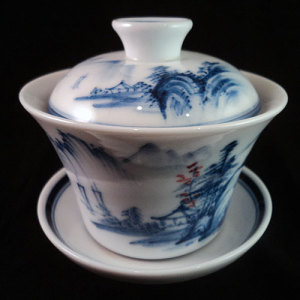note that this article was previously published on December 13th, 2014
A gaiwan is a special lidded bowl that is used for brewing tea. Invented during the Ming dynasty, the design has not changed much over time. It consists of a saucer, a small cup with a flared lip and a lid. The most common material is porcelain but you can also find gaiwans that are made out of glass or clay.
A large amount of leaves and a small amount of water is used to achieve concentrated flavor and aroma. Rather than brewing for 3 to 5 minutes like you would in a tea pot, the infusion time for a gaiwan can be as short as 15 seconds. The brewed tea is then poured into a cup or serving vessel, using the lid as a strainer to keep the leaves inside the bowl. Many tea connoisseurs enjoy sniffing the lid after each infusion to see what aromas they’re able to find in the tea.
Pouring tea with a gaiwan can be very tricky for the uninitiated. The basic idea is to hold the gaiwan from the rim and the button on top of the lid. I recommend practicing with cool water first so that you can get the technique down without risking burning yourself. It also takes some time and practice for your fingers to become accustomed to the heat. There are many methods for pouring but it’s important to do what works best for you.
 I have fairly long fingers so I have no problem gripping the very top rim of the gaiwan. Others with small hands may want to use the saucer as a means to grasp the gaiwan in a safer, more comfortable way. The positioning of your lid will help you to control the water temperature, if needed. Pu-erh loves heat so you’ll want to close the lid all the way. Green teas are easily scalded so it can help to leave an opening for steam to escape.
I have fairly long fingers so I have no problem gripping the very top rim of the gaiwan. Others with small hands may want to use the saucer as a means to grasp the gaiwan in a safer, more comfortable way. The positioning of your lid will help you to control the water temperature, if needed. Pu-erh loves heat so you’ll want to close the lid all the way. Green teas are easily scalded so it can help to leave an opening for steam to escape.
If you ask five tea drinkers what teas work best in a gaiwan you are likely to get five different answers. In my experience oolongs, black tea and pu-erh all perform very well. A high quality tea can be brewed upwards of ten times. White and green teas can be a bit more delicate so use your judgment. Chinese and Taiwanese teas tend to work best in gaiwans but I’ve had success brewing everything from Darjeeling to American grown white tea.
note that this post was previously published on July 9th, 2015




